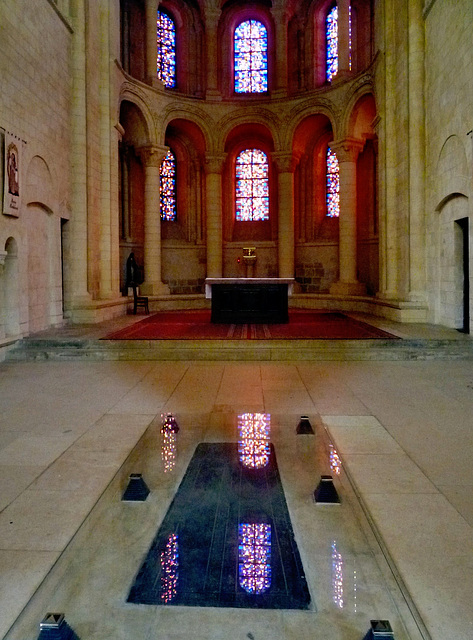Caen - Abbaye aux Dames
Caen - Abbaye aux Dames
Caen - Abbaye aux Dames
Caen - Abbaye aux Dames
Caen - Abbaye aux Dames
Caen - Abbaye aux Dames
Caen - Abbaye aux Dames
Caen - Abbaye aux Dames
Caen - Abbaye aux Dames
Caen - Abbaye aux Dames
Caen - Saint-Nicolas
Caen - Saint-Nicolas
Caen - Saint-Nicolas
Caen - Saint-Nicolas
Caen - Abbaye aux Hommes
Caen - Abbaye aux Hommes
Caen - Abbaye aux Hommes
Caen - Abbaye aux Hommes
Caen - Abbaye aux Hommes
Caen - Abbaye aux Hommes
Caen - Abbaye aux Hommes
Caen - Abbaye aux Hommes
Caen - Abbaye aux Hommes
Caen - Abbaye aux Hommes
Caen - Abbaye aux Hommes
Location
See also...
Keywords
Authorizations, license
-
Visible by: Everyone -
All rights reserved
-
192 visits
Caen - Abbaye aux Dames


Caen was a settlement already in Roman times, but prospered, when
William the Conqueror (aka "William the Bastard") built a castle here.
When William married Matilda of Flanders (~ 1051) a papal ban was issued
at the Council of Reims on the grounds of consanguinity. In 1059 Pope Nicholas awarded dispensation, after William and Matilda agreed to found
two monasteries as penance.
William founded the Abbey of Saint-Etienne (aka "Abbaye aux Hommes"),
Matilda founded with here husband´s support the Abbey Sainte-Trinité
(aka "Abbaye aux Dames"). The erection of both abbeys started in Caen
around 1060.
The community of nuns was suppressed by the French Revolution. In 1823
the local authorities transferred the ancient Hôtel-Dieu to the former
cloister for use as a hospital, and the canonesses regular established
themselves there. The canonesses continued to operate until 1908 when
the facility was transferred into a nursing home.
The former abbey church Sainte-Trinité now serves the parish.
Seen here is the grave of "Reine Mathilda", wife of William the Conqueror. Matilda was crowned Queen in 1068 and mother of nine kids, including two kings, William II and Henry I, and Cecilia, who was abbess of this monastery. Mathilda died in November 1083 and was buried here. Her husband died in 1087.
His grave is in the choir of Saint-Etienne, once the abbey-church of the Abbaye aux Hommes, less than a kilometer away.
Matilda´s tomb was vandalized during the Wars of Religions and later again during the French Revolution. Now the black slab, that marks the grave, is protected by safety glass.
William the Conqueror (aka "William the Bastard") built a castle here.
When William married Matilda of Flanders (~ 1051) a papal ban was issued
at the Council of Reims on the grounds of consanguinity. In 1059 Pope Nicholas awarded dispensation, after William and Matilda agreed to found
two monasteries as penance.
William founded the Abbey of Saint-Etienne (aka "Abbaye aux Hommes"),
Matilda founded with here husband´s support the Abbey Sainte-Trinité
(aka "Abbaye aux Dames"). The erection of both abbeys started in Caen
around 1060.
The community of nuns was suppressed by the French Revolution. In 1823
the local authorities transferred the ancient Hôtel-Dieu to the former
cloister for use as a hospital, and the canonesses regular established
themselves there. The canonesses continued to operate until 1908 when
the facility was transferred into a nursing home.
The former abbey church Sainte-Trinité now serves the parish.
Seen here is the grave of "Reine Mathilda", wife of William the Conqueror. Matilda was crowned Queen in 1068 and mother of nine kids, including two kings, William II and Henry I, and Cecilia, who was abbess of this monastery. Mathilda died in November 1083 and was buried here. Her husband died in 1087.
His grave is in the choir of Saint-Etienne, once the abbey-church of the Abbaye aux Hommes, less than a kilometer away.
Matilda´s tomb was vandalized during the Wars of Religions and later again during the French Revolution. Now the black slab, that marks the grave, is protected by safety glass.
- Keyboard shortcuts:
Jump to top
RSS feed- Latest comments - Subscribe to the comment feeds of this photo
- ipernity © 2007-2024
- Help & Contact
|
Club news
|
About ipernity
|
History |
ipernity Club & Prices |
Guide of good conduct
Donate | Group guidelines | Privacy policy | Terms of use | Statutes | In memoria -
Facebook
Twitter

Sign-in to write a comment.